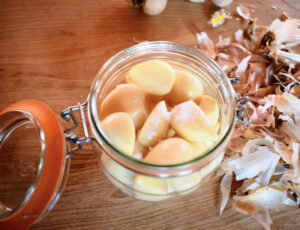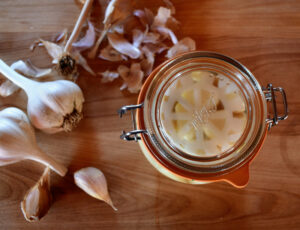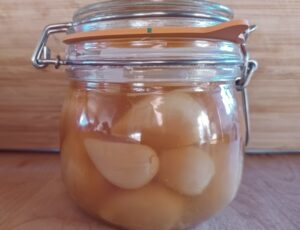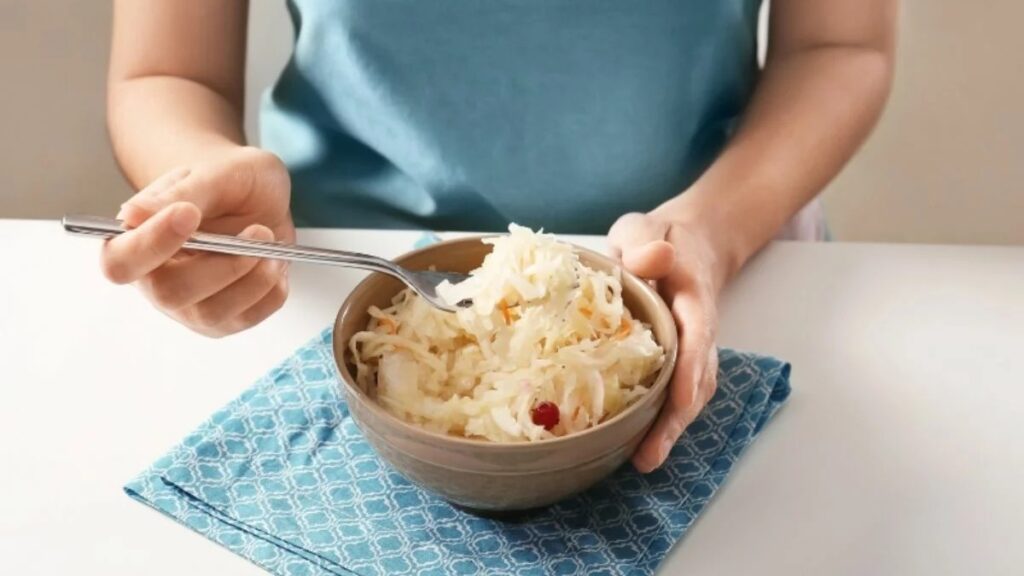Learn how to lacto-ferment garlic cloves in brine!
As surprising as it may sound, fermented garlic cloves can be crunched like candy (for experienced enthusiasts, or a Halloween idea 😂)! Lacto-fermentation reduces the spiciness of garlic but does not affect its flavour.
If we could, we’d put garlic in every one of our fermented vegetable recipes. We love to add it to sauerkraut, kimchi, pickles, and carrots… So why not make a jar with just garlic cloves, water, and salt?!
This article will give you all the information you need to understand what lacto-fermented garlic is, its benefits and how to make your recipe a success!
Go straight to the section that interests you:
Why Lacto-Ferment Garlic?
Fermented garlic should be available in every kitchen! Fermenting garlic has many benefits, including health benefits, storage, taste, and ease of use.
Health Benefits of Fermented Garlic
Garlic has been used for centuries for its health benefits. The ancient Greeks, Romans, Egyptians, and Chinese would have all used garlic as a medicine.
Garlic contains several powerful compounds, which are thought to have an impact on blood pressure, the immune system, and general health. (ref)
Garlic fermentation preserves the benefits of raw garlic. During fermentation, lactic acid bacteria retain the beneficial molecules, create new compounds, and increase the amount of antioxidants in garlic! (ref)
In addition, fermentation makes garlic easier to digest. Lacto-fermented garlic does not give you bad breath. The good molecules are also easier for the body to absorb once fermentation is complete.
Want to know more? Read our article on the benefits of fermented vegetables.
Storing Fermented Garlic
Fermented garlic can be stored for many years at room temperature. In fact, the longer it is left to ferment, the more delicious it becomes! Traditional Korean recipes recommend letting garlic ferment for up to 7 years!
Fermentation is a safe way to preserve garlic. Other techniques, such as preserving it in oil, are very dangerous.
Lacto-fermentation retains the texture, benefits, and flavour of garlic, with no risk of botulism or poisoning!
For more information, read Is Lacto-Fermentation Safe?
Taste of Fermented Garlic
Fermented garlic gets better with time. The longer you leave it to ferment, the faster you’ll get through the jar!
After two weeks, fermented garlic starts to lose its spiciness. After a month, it develops a nice acidity. After a year, it can be eaten as is, as an appetizer!
Some legends say that after 3 years, garlic becomes almost sweet and smooth in the mouth! Honestly, we’ve never managed to wait that long. We always finish the jar long before!
Ease of Use of Fermented Garlic
Having a jar of fermented garlic in your fridge is so convenient! You can simply grab already peeled garlic cloves for your recipes. You can also enjoy their milder taste than that of raw garlic. It is ideal for marinades, vinaigrettes, or salads.
The brine in which the garlic cloves are immersed can also be used in cooking. Very handy when you want to put garlic everywhere!
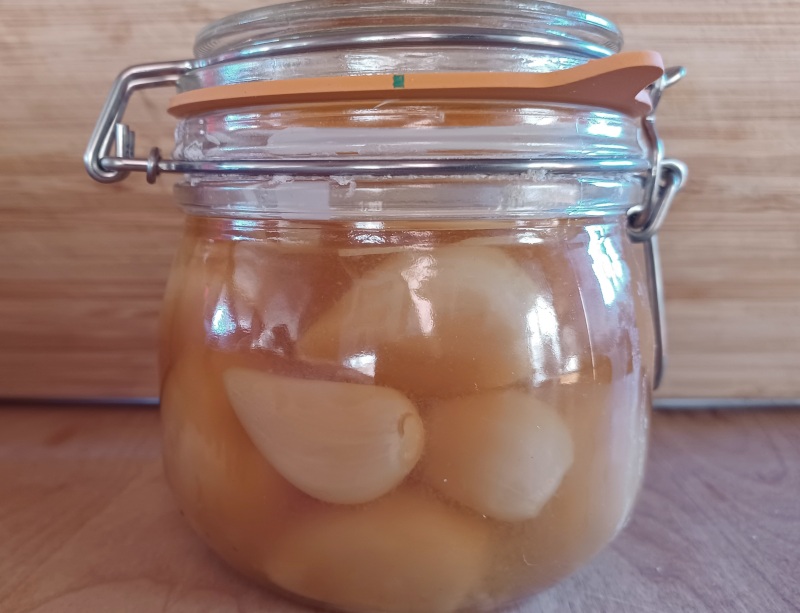
Ingredients for Fermented Garlic
Lacto-fermented garlic requires only three ingredients: garlic, salt, and water.
Garlic
The best garlic for making fermented garlic is recently harvested green garlic (late summer to autumn). It has a clean, less sulphurous taste and transforms deliciously with fermentation.
If the garlic is a little older, it will still work well, but the taste will be more pronounced.
Even if the garlic is sprouted, you can ferment it.
Avoid using garlic that has been frozen or dehydrated. This type of garlic works well when combined with other vegetables, but not on its own.
Salt
The salt used should not contain any additives or anticaking agents. The ingredient list should read: “salt”. That’s it!
For more information, see Which Salt for Lacto-Fermentation?
Water
The water used should not contain chlorine. Use filtered water or let tap water stand for half an hour before using it.
For more information, see Which Water for My Fermentations?
Did you know that you can ferment garlic in honey? See our recipe for fermented garlic honey to find out how.
Equipment for Fermenting Garlic
Fermented garlic in brine can be prepared with very little equipment.
The Jar
The jar used in this recipe is a Le Parfait type jar. These jars have lever locks to keep the fermentation environment airtight. They automatically release the excess pressure that builds up in the jar.
If you are using a screw top jar, such as Masons, you should use a plastic lid, as metal lids will rust over time (unless your fermentation only takes a few weeks)!
The Counterweight
The most important thing for successful lacto-fermentation is to keep the vegetables well submerged under the brine.
The use of a counterweight, such as ViscoDisc inserts, keeps the vegetables safe from the air on the surface.
You can use glass weights but be careful that they don’t fall off during fermentation!
We chose to use a Le Parfait jar and a counterweight, but there are several fermentation options. To find out about them, see What Equipment for Fermenting Vegetables?
Fermenting Garlic in 3 Steps
There are three main steps to preparing fermented garlic:
1. Prepare the Garlic Cloves
You have two options: peel the garlic cloves or keep the skin.
The first option provides ready-to-use garlic and clean brine. However, it requires some peeling by hand.
The second option offers the great advantage of having no prior preparation except to ensure that the cloves are generally clean. Once fermented, garlic cloves can be peeled effortlessly.
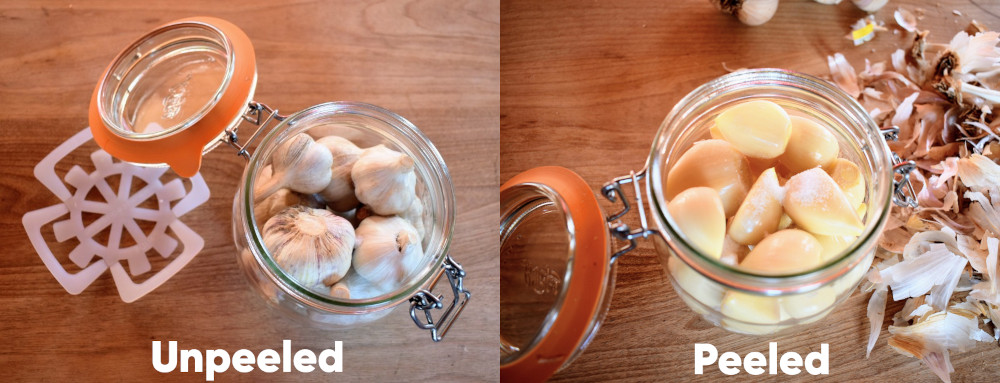
2. Put in a Jar
The garlic cloves are stacked in a jar and covered with water and salt. We recommend using a weight or insert to keep the garlic well submerged under the brine.
3. Leave to Ferment
Place the jar in a cupboard and forget about it until the next time you move. Fermentation time can range from a few weeks to several years.
The longer you let them ferment, the more like candy they become. They can remain crunchy for many months, and their flavours become more and more refined.
Note: fermented garlic can smell quite strong during fermentation. A garage or cellar is a good place to store the jar while it is fermenting.
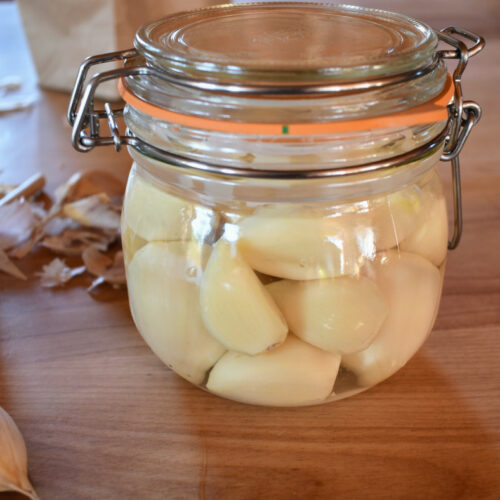
Fermented Garlic Recipe (Brine)
Equipment
- 1 Le Parfait glass jar 500ml
- 1 ViscoDisc insert large
Ingredients
- 8 bulb of garlic or enough cloves to fill the jar
- 2 tsp. salt
- water
Steps
Preparation of the garlic
- With a small knife and a lot of patience, separate the heads of garlic into cloves and peel them (optional)
Put in a jar
- Stack garlic cloves in the jar to about 2 inches from the rim
- Sprinkle salt over the cloves

- Add water to cover
- Close the jar and shake to dissolve the salt
- Open. Place the insert to keep the garlic cloves well immersed in the brine. If necessary, add a little more water to cover the insert.
- Close the jar

Fermentation
- Place the jar on a large plate to collect any overflow.
- Let it ferment at room temperature out of direct sunlight for at least 4 weeks.
- Once the jar is opened, place it in the fridge. Can be kept until civilization ends (and even after).

Notes
Why Does Fermented Garlic Turn Blue-Green?
Sometimes fermented garlic changes colour. Don’t worry, it’s perfectly normal. It happens very often. The blue and green colours are created by acidity.
It doesn’t affect the taste, texture, or safety of the product.
Read more: Why Is My Fermented Garlic Green?
How Do I Eat Lacto-Fermented Garlic?
Lacto-fermented garlic in brine is used wherever raw or cooked garlic is used.
Fermented garlic has a less spicy taste than raw garlic, so it is ideal for replacing raw garlic in recipes like:
- Homemade hummus
- Vinaigrette
- Pesto
- Guacamole
- Garlic butter
- Aioli
- Lacto-fermented garlic can also replace garlic in cooking. Chop it up and add it to your stir-fries, soups, and casseroles.
Don’t throw the brine away! It’s packed with flavour and is perfect for deglazing your stir-fry or marinating your proteins.
Another way to use fermented garlic is to puree it after fermentation.
- Drain the garlic cloves and reserve the brine
- Using a food processor or blender, puree the garlic cloves
- If necessary, add a little of the reserved brine until the desired consistency is reached
This garlic paste can be easily incorporated into vinaigrettes and marinades. It can be stored in the fridge for several months.
